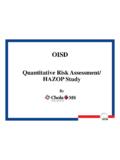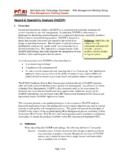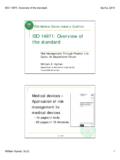Transcription of A Simplified Approach to Estimating Individual Risk
1 A Simplified Approach to Estimating Individual Risk Prepared by Amey VECTRA Limited for the Health and Safety Executive ii A Simplified Approach to Estimating Individual Risk Andrew Franks Amey VECTRA Limited Europa House 310 Europa Boulevard Gemini Business Park Westbrook Warrington WA5 7YQ The report describes a Simplified method of calculating Individual risk. The method described is a development of other semi-quantitative approaches such as the risk matrix or Layer of Protection Analysis [1]. The method may be useful in the context of performing risk assessments for the purposes of preparing safety reports under the Control of Major Accident Hazards Regulations 1999 (the COMAH Regulations) [2].
2 The method provides a Simplified means of obtaining a conservative estimate of the Individual risk to members of defined population groups. It can also be used to identify those event outcomes contributing most to the risk for each of the population groups specified. The method may be implemented within a spreadsheet. However, the effort involved in using the method increases rapidly as the numbers of event outcomes, population groups and hazardous material locations are increased. It is recommended that use of the method be considered when: The number of event outcomes of interest is modest (50-100); The hazardous materials on site are found at a few discrete locations (1-3); and The number of population groups of interest is small (5 or less).
3 This report and the work it describes were funded by the Health and Safety Executive. Its contents, including any opinions and/or conclusions expressed, are those of the author alone and do not necessarily reflect HSE policy. iii CONTENTS SUMMARY V ABBREVIATIONS VI 1. INTRODUCTION 1 The Control of Major Accident Hazards Regulations 1999 1 The Risk Matrix 1 2.
4 DESCRIPTION OF METHOD 3 Step 1: Define Probability and Frequency Categories 3 Step 2: Define Population Groups of Interest 4 Step 3: Define Event Outcomes of Interest 7 Step 4: Estimate Frequencies of Event Outcomes 8 Step 5: Estimate Consequences of Events 10 Step 6: Determine the Impacts of Event Outcomes at Locations of Interest 11 Step 7: Estimate Individual Risk 12 3. RELATIONSHIP WITH THE RISK MATRIX 20 Example 23 4. EFFECT OF RISK REDUCTION MEASURES 28 Example 28 5.
5 SUMMARY AND CONCLUSIONS 33 6. REFERENCES 34 APPENDIX A CHLORINE WORKED EXAMPLE 35 A1. Introduction 36 A2. Step 1: Define Probability and Frequency Categories 37 A3. Step 2: Define Population Groups 38 A4. Step 2: Define Event Outcomes of Interest 40 A5. Step 3: Estimate Frequencies of Event Outcomes 41 A6. Step 4: Estimate Consequences of Events 43 A7. Step 5: Determine the Impacts of Event Outcomes at Locations of Interest 44 A8.
6 Step 6: Estimate Individual Risk 45 A9. Risk Matrix 56 A10. Risk Reduction 62 A11. References 72 APPENDIX B LPG WORKED EXAMPLE 73 B1. Introduction 74 B2. Step 1: Define Probability and Frequency Categories 75 B3. Step 2: Define Population Groups 76 B4. Step 3: Define Event Outcomes of Interest 78 B5. Step 4: Estimate Frequencies of Event Outcomes 79 B6. Step 5: Estimate Consequences of Events 81 B7.
7 Step 6: Determine the Impacts of Event Outcomes at Locations of Interest 82 B8. Step 6: Estimate Individual Risk 83 iv B9. Risk Matrix 94 B10. Risk Reduction 100 B11. References 112 v SUMMARY This study has been performed under contract to the Health and Safety Laboratory. The project under which this report was prepared comprises three tasks: Task 1: A Study of Layers of Protection / Lines of Defence Methodologies. Task 2: A Review of Risk Reduction Measures.
8 Task 3: Simplified Approaches to Individual Risk. This report represents the deliverable under Task 3. The report describes a Simplified method of calculating Individual risk. The method may be useful in the context of performing risk assessments for the purposes of preparing safety reports under the Control of Major Accident Hazards Regulations 1999 (the COMAH Regulations) [2], where use of a semi-quantified Approach is justified. The methodology presented is a development of the Approach for calculating Individual risk as outlined in the CCPS publication on LOPA [1], combined with elements of the procedure usually undertaken in order to construct a risk matrix.
9 The method provides a Simplified means of obtaining a conservative estimate of the Individual risk to members of defined population groups. It can also be used to identify those event outcomes contributing most to the risk for each of the population groups specified. The method may be implemented within a spreadsheet. However, the effort involved in using the method increases rapidly as the numbers of event outcomes, population groups and hazardous material locations are increased. It is recommended that use of the method be considered when: The number of event outcomes of interest is modest (50-100); The hazardous materials on site are found at a few discrete locations (1-3); and The number of population groups of interest is small (5 or less).
10 Hence the method is likely to be of use at, for example, chlorine water treatment works or bulk LPG storage facilities in relatively sparsely populated areas. However, it may only be of limited use at more complex establishments in more densely populated areas. Several of the steps in the methodology are identical with the corresponding steps in the preparation of a risk matrix. It is possible to use the method to estimate Individual risk and construct a risk matrix as a parallel activity. It has been observed that those events contributing most to Individual risk are not necessarily the same as those events contributing most to societal risk.
















